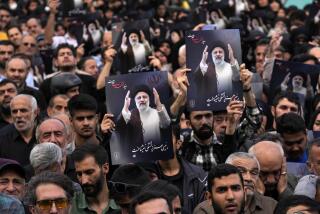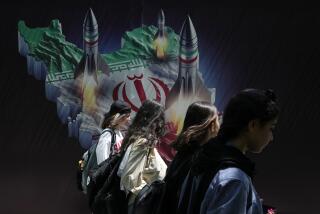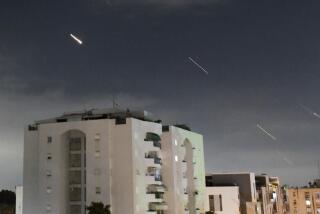Reporters Shown Captured Port : Iran Holds Foe’s Territory but Iraq Dominates Skies
- Share via
AL FAW, Iraq — The red, white and green flag of Iran’s revolutionary government billowed over the shell-pocked mosque and other major buildings in this former Iraqi oil port Wednesday, symbols of the success of Iran’s latest offensive against Iraq.
While the authorities in Tehran are ecstatic about seizing an estimated 315 square miles of the boot-shaped Faw Peninsula, Iranian control is limited to the ground. Iraq continues to dominate the skies, a factor that may figure prominently in determining the outcome of the five-year-old Iran-Iraq War.
The Iranians, who crossed the Shatt al Arab waterway Feb. 9, are now well entrenched in Al Faw and its environs. To show off their gains, they escorted a group of foreign correspondents Wednesday on a tour of the town and the area several miles to the west.
During the tour, however, Iraqi bombers and other warplanes ranged freely over the front lines, although at a high altitude. They made at least seven attacks in four hours.
A correspondent for a West German magazine collapsed and died, apparently of a heart attack, after the press party was forced to run for the limited cover of a muddy embankment during the first bombing run of the day. That urgent search for shelter was repeated half a dozen times.
The Iraqi attack appeared aimed at destroying the jetty where the Iranians, using Yamaha speedboats, were ferrying men and supplies across the Shatt al Arab, an estuary formed by the confluence of the Tigris and Euphrates rivers that empties into the Persian Gulf and that forms the southern Iran-Iraq border. Iranians call it the Arvan River.
The latest offensive, now 11 days old, represents the first time that Iranian forces have seized a piece of Iraqi territory west of the Shatt al Arab. In alliance with Kurdish rebels, the Iranians have controlled parts of northern Iraq for several years.
So far, the Iranian victory appears to have been mostly symbolic because Al Faw, which was Iraq’s principal oil outlet to the sea in 1980, was abandoned as an oil terminal in the first week of the war and has little strategic value.
But its capture is a severe psychological blow to the regime of Iraqi President Saddam Hussein, which has yet to acknowledge the loss publicly. It could prove doubly so if Iran fulfills speculation that it is planning a second front north of the city of Basra, Iraq’s second-largest city, now that Iraq has been forced to commit its troops in defense of the Al Faw sector.
At a briefing before the press tour, Iranian officers said their forces have advanced seven miles north of Al Faw along the Shatt al Arab and 12 miles west toward the Kuwaiti border. The land taken includes a salt manufacturing facility about 10 miles northwest of Al Faw, which the officers said had been the forward headquarters of the Iraqi 7th Army’s 26th Brigade.
One officer, a Revolutionary Guard commander named Mohammed Nosit, said that in the first week of the offensive, Iran killed 15,000 Iraqis, captured 2,200 troops and seized 700 Iraqi tanks. Iranian casualties were not given.
Nosit said Iran’s immediate goal is to threaten Basra to the north, but he added that it is important to press westward toward Umm al Qasr, the Iraqi garrison town near the border with Kuwait. “Becoming a neighbor of Kuwait will help in our political calculations,” Nosit remarked.
The Kuwaitis are terrified at the prospect of a victory by non-Arab Iran and have helped to fund the Iraqi war effort. In addition, much of Iraq’s imports enter through Kuwait.
Peering Across Gap
As if to emphasize the point, correspondents were taken to a captured Iraqi missile base only a few hundred yards from Kuwait’s Bubiyan Island, where Kuwaiti forces peered across the narrow gap from bunkers.
An extraordinary aspect of the Iranian offensive is that despite receiving a warning, the Iraqis were taken off guard by a much less powerful fighting force.
“No one thought the warriors of Islam would cross the river, not even in the shah’s time,” said one Iranian commander, referring to the deposed monarchy of Shah Mohammed Reza Pahlavi.
The Shatt al Arab is several hundred yards wide and subject to 10-foot tides, according to the officers. An Iranian army colonel, Karim Abudat, who was trained at Ft. Bragg, N.C., acknowledged that the offensive was largely the work of Iran’s paramilitary Revolutionary Guards and volunteers known as Basij.
The regular army, he said, played a secondary role such as providing artillery support.
Only Lightly Armed
The tour of the front also suggested that the volunteers are only lightly armed.
A factor in Iran’s favor is that this is the wet season around Al Faw, making it difficult for Iraq to use its tank superiority to full advantage. The area is covered with thick mud that clings to clothes like glue.
The Iranians have captured several dozen Iraqi T-72 tanks, which they now use. They also have light artillery and anti-aircraft weapons scattered around the captured town.
However, they appear to have little in the way of air defenses, such as surface-to-air missiles. Journalists were shown one downed Iraqi MIG--the pilot trapped inside with his hand extended in a bizarre death pose--but there was no visible evidence of their claims of having shot down several dozen planes.
Al Faw itself has been heavily damaged, apparently by shelling rather than street fighting. The town’s oil-tank farm is still burning, some of the tanks collapsed in shapes that resemble soft ice cream.
Few Bodies Seen
In their four-hour tour of the town, the journalists saw only a handful of bodies, and it appeared that there had been little hand-to-hand combat. No civilians were visible.
The Iraqis could face a difficult time dislodging the invaders from Al Faw, since the Iranians are extremely well entrenched and are fanatic fighters.
As reporters drove through Al Faw, the occupying troops emerged from the concrete and stone houses, where they were taking shelter, to raise their fists in revolutionary salutes.
“Down, down, U.S.A.!” they chanted in a reminder of their hostility toward the United States since the 1979 revolution that toppled the shah. Some wore over their hearts pictures of the Ayatollah Ruhollah Khomeini, Iran’s supreme leader.
Anti-Gas Protection
Nearly every Iranian soldier was equipped with protective clothing for use against poison gas, which they accuse the Iraqis of using repeatedly since the current Iranian offensive began. One Iraqi plane dropped bombs near Al Faw that erupted in large white plumes of smoke, which the Iranians identified as gas. The reporters also saw wounded with what appeared to be gas burns being evacuated from the battlefield.
The journalists were taken to the area in three U.S.-made Bell helicopters that were delivered to Iran before the shah’s overthrow.
Moments after the helicopters landed, Iraqi warplanes attacked, sending many of the reporters and their Iranian escorts sprawling unceremoniously in the mud. It was afterward that the West German correspondent--Wolf Steinbauer, 48, Middle East editor of the newsweekly Der Spiegel--suffered his fatal heart attack.
Deafening Anti-Air Fire
Several times during the trip, reporters were forced to take cover behind dirt mounds as Iraqi warplanes ranged overhead, drawing deafening Iranian anti-aircraft fire.
The firing was too slow and too low to hit the Iraqis, but as one Iranian officer put it, “It keeps them flying high and relatively blind.” After four hours in Al Faw, the Iranians abandoned any hope of taking the correspondents out by helicopter. The visitors were placed in the large gray Yamaha glass fiber speedboats and ferried across the Shatt al Arab, where trucks took them to a rear field hospital.
Just before they left, three high-flying Tupolev bombers dropped parachute bombs in the area near the jetty. An old Iranian soldier clutching a Koran in one hand and a Kalashnikov rifle in the other looked up at the Iraqi planes, laughed, shook his rifle and shouted: “Allahu akbar! Allahu akbar!”-- God is great.
More to Read
Sign up for Essential California
The most important California stories and recommendations in your inbox every morning.
You may occasionally receive promotional content from the Los Angeles Times.












